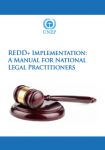Developed by the UN Environment Programme (UNEP) in cooperation with UN-REDD, the implementation manual on reducing emissions from deforestation and forest degradation, and promoting the conservation, sustainable management of forests, and enhancement of forest carbon stocks (REDD+) aims to provide legal practitioners in REDD+ countries, particularly partner countries of the UN-REDD Programme, with information on assessing national legal frameworks and associated gaps as well as suggestions on options to address key REDD+ legal issues.
 November 2015: Developed by the UN Environment Programme (UNEP) in cooperation with UN-REDD, the implementation manual on reducing emissions from deforestation and forest degradation, and promoting the conservation, sustainable management of forests, and enhancement of forest carbon stocks (REDD+) aims to provide legal practitioners in REDD+ countries, particularly partner countries of the UN-REDD Programme, with information on assessing national legal frameworks and associated gaps as well as suggestions on options to address key REDD+ legal issues.
November 2015: Developed by the UN Environment Programme (UNEP) in cooperation with UN-REDD, the implementation manual on reducing emissions from deforestation and forest degradation, and promoting the conservation, sustainable management of forests, and enhancement of forest carbon stocks (REDD+) aims to provide legal practitioners in REDD+ countries, particularly partner countries of the UN-REDD Programme, with information on assessing national legal frameworks and associated gaps as well as suggestions on options to address key REDD+ legal issues.
As a necessary part of preparing and scaling up for REDD+ activities, countries will need to assess the extent to which national legal frameworks are consistent with applicable international law and guidance, and how they best support the successful implementation of REDD+. Effective REDD+ implementation could well require changes to laws, regulations, policies and institutions in REDD+ implementing countries. The purpose of this manual is thus to provide information on assessing national legal frameworks and associated gaps, as well as suggestions on options to address key REDD+ legal issues. The intended audience of the manual includes national REDD+ programme coordinators, experts involved in REDD+ readiness legal and regulatory framework review and reform, as well as forest, land and carbon use rights.
The review of policies and suggestions for assessing national legal frameworks broadly focus on two phases: gathering information on laws, regulations, policies and institutions related to forests and forest governance; and assessing whether the existing national legal framework is consistent with international law and best practice related to REDD+ readiness experiences. Suggestions are based on decisions adopted by the Conference of the Parties to the UNFCCC, and guidance developed by the UN-REDD Programme’s participating UN agencies; and broadly consider needs to ensure consistency between national legislation and international law.
Individual chapters provide suggestions on the steps that practitioners should consider in assessing national legal frameworks, bearing in mind that the appropriate legal responses addressed in each chapter will vary depending on national circumstances and on the REDD+ technical issue being addressed. Overall, the chapters recommend the following steps for successful REDD+ implementation: identify and understand the body of international law and guidance that applies to a country; identify relevant REDD+ stakeholders; identify and assess the laws, regulations, policies and institutions that are involved in forest governance and land-use planning at the national level; assess the existing legal framework governing legally significant aspects of REDD+ implementation; and identify the legal responses or legislative measures that are most appropriate in a country. [Publication: REDD+ Implementation: A Manual for National Legal Practitioners]